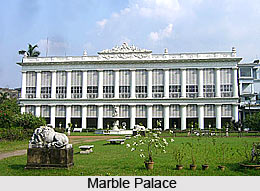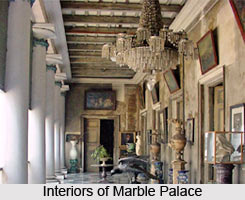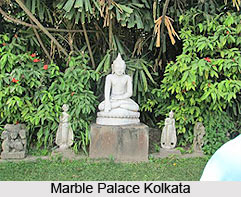 A 19th century mansion, the Marble Palace is situated in North Kolkata in the state of West Bengal. The Marble Palace is in vicinity to the house of the famous aristocrat family of Kolkata, and at large Bengal, the Tagores and the master-poet, Rabindranath Tagore. This exquisite Marble Palace is a marvellous construct made of exclusive Italian marbles. The great connoisseur of art, Raja Rajendra Mullick Bahadur patronized the building of this magnificence.
A 19th century mansion, the Marble Palace is situated in North Kolkata in the state of West Bengal. The Marble Palace is in vicinity to the house of the famous aristocrat family of Kolkata, and at large Bengal, the Tagores and the master-poet, Rabindranath Tagore. This exquisite Marble Palace is a marvellous construct made of exclusive Italian marbles. The great connoisseur of art, Raja Rajendra Mullick Bahadur patronized the building of this magnificence.
The wonderful Marble Palace building accommodates a heritage-glorifying art-gallery. Branded as one of the Heritage Buildings in Kolkata, the Marble Palace houses artefacts imported from Europe, oil paintings, having authentic version as well as imitations, and a diverse medley of Chinese and Japanese porcelain cumulatively contributing to the crowning glories. The palace has also a huge collection of numerous art works, statues, oil paintings brought in from many European countries.
History of Marble Palace
Built in 1835 by a French architect for Raja Rajendra Mullick, an affluent Bengali merchant and art connoisseur, the Marble Palace was constructed with a passion of preserving the exquisite works of art. The house continues to be a residence for his descendants, and the current occupants are the family of Raja Rajendra Mullick Bahadur. Raja Rajendra Mullick was the adopted son of Nilmoni Mullick, who built a Jagannath temple which predates the Marble Palace, and still stands within the premises, but is only accessible to members of the family.
The Marble Palace is famous for its sparkling white marble walls and floors, from which it has derived its present name. The palace also has an exquisite collection of Western sculpture and Victorian furniture. There is a private zoo, which was the first zoo in India, unveiled by Raja Rajendra Mullick. The mansion has a grand portico with stucco work and 6 Tuscan columns and the ground floor and first floor each have 14 Corinthian columns.
Architecture of Marble Palace
The Marble Palace has the predominance of the Gothic style of architecture but then traces of the Greek, Roman and Oriental styles can be observed, where these styles are harmoniously blended to give an impressive view. The structure of the mansion is originally Neoclassical in style and it merges with traditional Bengali style of architecture with open courtyards. Adjacent to the courtyard, there is a "Thakur-Dalan" which is basically a place of worship for members of the family. The British period, in which the building was constructed, is reminiscent from the articles that are contained in it and also by the style of architecture.
 The Mullick family had close links with the British who supported them in its formation. This is conspicuous from the name `Marble Palace` given by Lord Minto, a big shot of the British administration. The 3-storey building has tall fluted Corinthian pillars and ornamented verandas with fretwork and sloping roofs, built in the style of a Chinese pavilion. The premises also include a garden with lawns, a rock garden, a lake and a small zoo.
The Mullick family had close links with the British who supported them in its formation. This is conspicuous from the name `Marble Palace` given by Lord Minto, a big shot of the British administration. The 3-storey building has tall fluted Corinthian pillars and ornamented verandas with fretwork and sloping roofs, built in the style of a Chinese pavilion. The premises also include a garden with lawns, a rock garden, a lake and a small zoo.
Collections at Marble Palace
The house contains large quantities of Western sculpture and Victorian furniture, paintings by European and Indian artists and objects. Decorative objects include large chandeliers, clocks, floor to ceiling mirrors, urns, and busts of kings and queens. The Marble Palace entirely constructed of 126 different varieties is believed to have been brought from places all over India for floors, walls, and tabletops all marbled. It is a 3-storied building, having Corinthian pillars and verandas, which resemble Chinese pavilion. It is set against the backdrop of a large lawn having sculptures of Jesus Christ, the Virgin Mary, Hindu Gods, The Buddha and Christopher Columbus. The centre of the lawn on which stands the palace has a very nicely curved marble fountain.
 The building from inside is augmented with large halls in succession, which are occupied with beautiful paintings and other works including the ones of the likes of Titian, Gainsborough, Rubens and Sir Joshua Reynolds. The house is said to contain 2 paintings by Rubens, "The Marriage of St. Catherine" and "The Martyrdom of St. Sebastian". There are also said to be 2 paintings by Sir Joshua Reynolds, "The Infant Hercules Strangling the Serpent" and "Venus and Cupid". Other artists said to figure in the collections include Titian, Murillo and John Opie.
The building from inside is augmented with large halls in succession, which are occupied with beautiful paintings and other works including the ones of the likes of Titian, Gainsborough, Rubens and Sir Joshua Reynolds. The house is said to contain 2 paintings by Rubens, "The Marriage of St. Catherine" and "The Martyrdom of St. Sebastian". There are also said to be 2 paintings by Sir Joshua Reynolds, "The Infant Hercules Strangling the Serpent" and "Venus and Cupid". Other artists said to figure in the collections include Titian, Murillo and John Opie.
The collection of art objects is lavish, though random. Genuinely valuable pieces of art share space with a lot of kitschy art objects of little value. Another hallmark of the Marble Palace is a pocket-sized zoo, housing birds and herbivorous animals. This curious assembly of the fauna can enlighten a visitor with data on the natural world. An amazing collection of 82 varieties of elegantly decorated antique clocks make it more interesting.
Marble Palace Zoo
Located next to the palace is the Marble Palace Zoo, the first zoo opened in India, also by Raja Rajendra Mullick. It now primarily serves as an aviary, including peacocks, hornbills, pelicans, storks and cranes. The menagerie also contains monkeys and several species of deers.
Visiting Information on Marble Palace
The nearest metro station to the Marble Palace is the Esplanade metro at a distance of about 3.3 km. And the Sealdah railway station is the closest at a distance of about 2.8 km while the Netaji Subhash Chandra Bose International Airport is nearby at a distance of 15 k from the Marble Palace. The Marble Palace is open all days of the week except on Mondays and Thursdays.



















